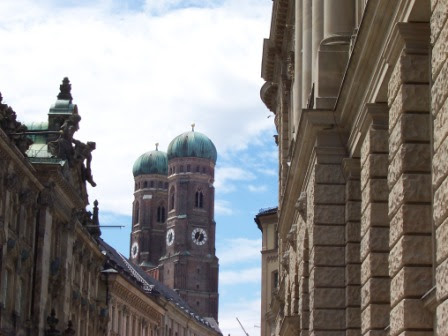Berlin versus Munich - An Insider's Comparison
It is quite difficult to find two more dramatically contrasting cities within the same country than Berlin and Munich. Aside from both being large ‘German’ cities that have previously hosted the Summer Olympic Games, there isn’t much else they have in common. The capital of Prussia and the capital of Bavaria have different historical paths, different demographics, different economies, different politics, different geographies, different dialects, different beer; the list goes on and on.
1871 marked a special year in the relationship between Berlin and Munich. It was in this year that Germany became a unified empire under the rule of a Prussian Kaiser with Berlin as its capital. After this first unification of Germany, Munich and Berlin were always in competition. The huge disparity between these cities further amplifies their comparison, creating polarizing viewpoints as to which city should be known as the “best German city”. Berliners can not only list a million reasons why Berlin outclasses Munich in every imaginable manner, but they can also list a billion reasons why Munich is the last place they’d ever wish to reside. Conversely, the same rationale applies to those from Munich. It is, however, not just longtime city residents who voice their opinion on this controversial topic. Whether it be tourists, exchange students, expats, or displaced Germans, it seems everyone strongly favors one city to the other.
One of the main differences between the two cities is their size. Berlin is a true metropolis with a population of around 3.5 million in an area 1.5 times larger than that of Chicago. Munich is only one third the size of Berlin in terms of city area and, despite its 1.3 million population, can be described as having the look and feel of a large town rather than a city.

Although both cities were founded within 80 years on another, Munich became significant much earlier. The city was the birthplace of Louis IV who was crowned Holy Roman Emperor in 1314. Eight years later Munich was awarded a lucrative salt monopoly assuring the city of great wealth. This paved the way for many of the city’s landmark buildings, such as the Frauenkirche, the Michaelkirche and the Hofbräuhaus, to be built in artistic and religious movements of the 15th and 16th centuries. The quaint old town of Munich is much more vital to the city’s identity because of its historical importance, as well as its size in proportion to the overall city.
While Berlin also has medieval origins, the city remained comparatively insignificant until it became capital of the Prussian kingdom at the beginning of the 18th century. Berlin’s old town of Nikolaiviertel is not only much smaller than Munich’s old town, but is further minimized by the multitude of surrounding 18th century Prussian influences. The industrial transformation of the city into a modern metropolis, the destruction of the city during World War II and the lack of solidarity as a divided city until 1989, are all important reasons behind Berlin’s unique, eclectic and chaotic appearance.
These differences lead to contrasting city atmospheres and experiences. Many American tourists are disappointed by Berlin because it does not meet their expectations as a “traditional European city” in the way that Munich does. Munich is appealing to many tourists because much of the city’s cultural highlights can be seen in a couple days and by foot. With its medieval roots, large old town blended with a huge, tranquil park in Englischer Garten and beautiful, urban beer gardens such as Augustiner, its a perfect city for a tourist looking to spend a couple relaxing days of vacation.

As a metropolis, Berlin is much more vibrant, loud and intimidating. While Munich can more easily be framed as a cozy and traditional German city, Berlin is far too diverse for such stereotyping. Berlin is also too large to seen solely by foot. Cycling in the city is possible, but much more hectic than in Munich and is rather unsafe without prior cycling experience within the city. Therefore, one is heavily reliant on public transportation and city tours to get around. The bustling and frenzied nature of a metropolis creates a less patient and forgiving mentality among Berlin’s population, which can often be perceived as extreme rudeness.
When spending a substantial amount of time as a tourist or living as a temporary or permanent resident, Berlin’s appeal increases exponentially. This is, however, not to imply that Munich is superficial or unideal for longer durations than a couple days. There is plenty to experience outside of the comfortable confines of Munich’s city center. The quality of Munich’s city center also makes it an appealing place to consistently return. The city’s strong economy and high standard of living, both the best of any large city in Germany, play a substantial role in keeping the city clean, the people friendly and crime down. However, the relative ease of living in Munich can sometimes be viewed as limited, boring and exclusive.
Compared to Munich, Berlin’s complexity requires additional time to become properly acclimated. Once this transitional period is overcome, the Berlin experience can be quite exhilarating. Although not yet the “melting pot” of New York City, Berlin is much more inviting to a wider range of people. More than any other German city, Berlin has a multi-cultural feel with around 30% of its population having an origin outside of Germany. Three universities in the city, four if you include Potsdam, make Berlin home to many students and academics. The city’s affordable living and vibrant night scene is appealing to students and young non-students alike. This demographic is the heart of the large supply of educated and inexpensive labor, leading many to refer to Berlin as the new start-up center of Europe. The city’s large parks, collection of cultural attractions and low crime rates make the city incredibly family-friendly.
However, don’t expect to leave Berlin with riches. Its economy is still trying to recover to its industrial glory days. The Hyperinflation, Great Recession, World War II, Soviet occupation and Re-unification have made this transition extremely difficult. Berlin has three times the unemployment of Munich and a scandalously high rate of people depending on welfare payments and children living in poverty.
I hope you have enjoyed this first post from the “travel comparison” blog on Wandering Educators. I thought this post would be the perfect starting point to this blog, as it is a topic near and dear to my heart. I first learned German back in 1999 living with a host family in Berlin. I was fortunate enough to be able to spend another year in Berlin studying abroad as an exchange student in 2004. Since 2010, I have made Berlin my home. I also had the opportunity to live and work in Munich in 2006. I have heard many opinions from friends and acquaintances regarding their love/hate relationships with both cities. My “neutral” foreigner status coupled with the extended time spent in both Berlin and Munich, provides me with the authority and objectivity necessary to have written this “macro” comparison of these two great German cities.
While writing this first post, I realized I have far too much to write about this topic for one post. Therefore, I plan on writing a follow-up post on this topic as part of this blog. In part two, Munich and Berlin will be compared in more depth at various “micro” levels. These “micro” levels of comparison will include, among others: language, beer & food cultures, parks, geography, public transportation systems and nightlife.
Travis Shirk is the Travel Comparison Editor for Wandering Educators. Originally from Tucson, AZ, he is now based in Berlin, Germany where he works for the UK travel comparison site flights.idealo.co.uk. Travis holds a Masters in Information and Library Science, has studied abroad in Germany and taught abroad in Denmark.



















